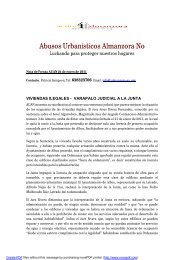European Property Rights and Wrongs - Diana Wallis MEP
European Property Rights and Wrongs - Diana Wallis MEP
European Property Rights and Wrongs - Diana Wallis MEP
You also want an ePaper? Increase the reach of your titles
YUMPU automatically turns print PDFs into web optimized ePapers that Google loves.
level <strong>and</strong> provides a counterweight to centralised Brussels-based decision making.<br />
This conundrum is well illustrated by the sometimes shrill debate over the<br />
<strong>European</strong> Contract Law Project; a common or coherent approach to contract law<br />
is seen as having the potential to increase legal certainty <strong>and</strong> confidence <strong>and</strong><br />
deliver a huge boost to cross-border trade. Whatever the benefits this is seen<br />
as encroaching on the sensitive core of national civil law born of separate legal<br />
cultures <strong>and</strong> traditions. The final way out of this impasse has been to go in the<br />
direction of an optional instrument which parties to a cross-border transaction<br />
can elect to use. This might in future have the potential to help certain surrounding<br />
elements of a property purchase.<br />
The reasons that real property, real estate, l<strong>and</strong>, bricks <strong>and</strong> mortar – whatever<br />
you may call it – are treated differently lie in their immovability. The subject<br />
of the purchase is literally part of the l<strong>and</strong> of the state where it is located; the<br />
way in which it is treated affects not just the property itself but the environment<br />
of the whole neighbourhood or region. Similarly, the rights created <strong>and</strong><br />
passed on relate to the cultural fabric of the community, the way the citizen,<br />
the family <strong>and</strong> marriage are viewed <strong>and</strong> treated in law. There are two basic<br />
underlying approaches of dealing with real property, these are represented by<br />
the two main european legal traditions the Civil Law <strong>and</strong> the Common Law. The<br />
Civil Law tradition is based on the reception of Roman law <strong>and</strong> the establishment<br />
of a predictable <strong>and</strong> st<strong>and</strong>ardised model of rights <strong>and</strong> obligations used by<br />
courts; whereas Common Law is based on the historical decisions of Courts <strong>and</strong><br />
Tribunals <strong>and</strong> the interpretation of those decisions by Judges.<br />
Both traditions have their advantages <strong>and</strong> supporters, <strong>and</strong> it must be borne<br />
in mind when considering any reform that such basic issues as the rights to the<br />
l<strong>and</strong> under our feet <strong>and</strong> the roof over our head are based on legal practice that<br />
has developed over hundreds of years; they cannot be unpicked at a stroke by a<br />
simple regulation or directive. The issue is even more complex when the future<br />
expectations of those who will inherit real property are taken into account, wills,<br />
trusts, estates planning, pension funds <strong>and</strong> matrimonial rights are all affected.<br />
Again many of these elements are already the target of the <strong>European</strong> legislator in<br />
a search to facilitate daily life in the <strong>European</strong> space.<br />
Part of the problem for those purchasing property in another state may be a<br />
conceptual one, the very notion of ownership <strong>and</strong> other property rights may be<br />
completely different from the one they are familiar with. In addition, the practice<br />
9



